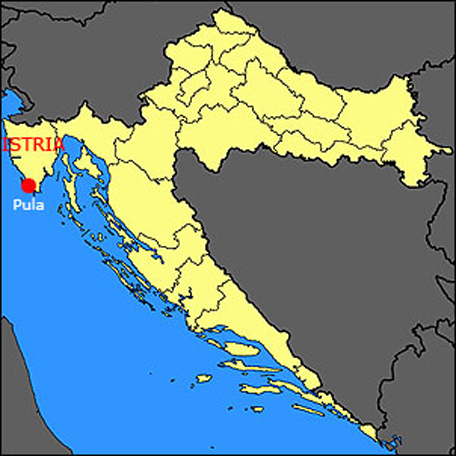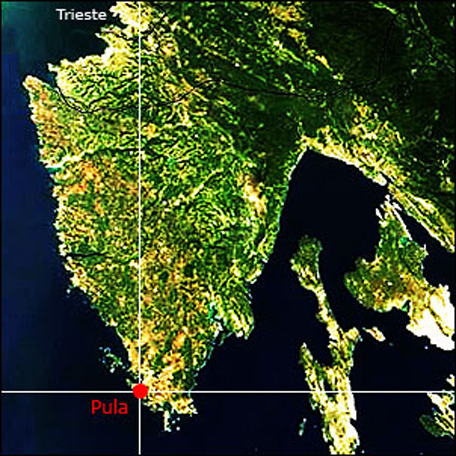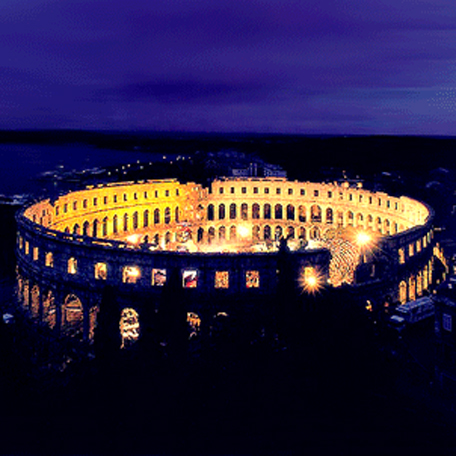|
|
|
|
|
|
|
|
|
|
|---|---|---|---|---|---|---|---|---|
|
|
|
|
|
|
|
|
|
|
|
|
|
|
|
|
||||
|
|
|
|
|
|
|
|
|
|
|
|
|
|
|
|
|
|
|
|
|
|
|
|
|
|
|
|
|
|
|
|
|
|
|
|
|
|
|
|
|
Welcome to Pula Istria |
||||||||
|
|
|
|
|
|
|
|
|
|
|
|
|
|
|
|
|
|
|
|
|
|
|
|
|
|
|
|
|
|
|
|
Welcome to Pula |
|
|
|||||
|
|
|
|
|
|
|
|
|
|
|
|
|
|
|
|
|
|
|
|
|
|
|
|
|
|
|
|
|
|
|
|
|
|
|
|
|
|
|
|
|
|
|
|
|
|
|
|
|
|
|
|
|
|
|
|
||||
|
|
|
|
|
|
|
|
|
|
|
|
|
|
|
|
|
|
|
|
|
|
|
Almost at the southern tip of Istria, on its south-western coast, the largest town on the peninsula.
Since Istrian history goes back 3.000 years Pula and its territory offers a variety of attractions to lovers of culture.
Many have been ruling this land: the Illyrian-Venetian Histri, the ancient Romans, the Goths, the Lombards, the Holy Roman Empire, the Republic of Venice, Napoleon's Empire, the Austro-Hungarian Empire, the Italian Kingdom of Mussolini, Hitler's Germany and Tito's Yugoslavia... |
|
|
||||
|
|
|
|
|
|
|
|
|
|
|
|
|
|
|
|
|
|
|
|
|
|
|
|
|
|
||||
|
|
|
|
|
|
|
|
|
|
|
|
|
|
|
|
|
|
|
|
|
|
|
After the break-up of the Yugoslavian Federation in 1991 Istria lies now in three countries: Croatia, Slovenia and Italy.
Pre-history shows here the presence of Homo erectus already 1 million years ago and the human settlements, starting as from 6,000 BC, evolve into so called "gradine" by Proto Illyrians in the Bronze Age.
Dubious the foundation of a Polai by the Greeks, but historic Pula's latin name which was given by its founder, Cassius Longinus: Colonia Pietas Iulia "Pola" Pollentia Herculanea. |
|
|
||||
|
|
|
|
|
|
|
|
|
|
|
|
|
|
|
|
|
|
|
|
|
|
|
|
|
|
||||
|
|
|
|
|
|
|
|
|
|
|
|
|
|
|
|
|
|
|
|
|
|
|
Every step you take through the old town is a landmark, foremost its numerous monuments of Roman architecture.
First among them all the almost intact Roman amphitheatre "Pula Arena" (27 BC-68 AD) of course, in fact the sixth largest in the world and certainly one of the most beautiful, but also the Triumphal Arch of the Sergii from the 1st century BC, the Gate of Hercules and Twin Gates, the Temple of Augustus and the Small Roman Theatre. |
|
|
||||
|
|
|
|
|
|
|
|
|
|
|
|
|
|
|
|
|
|
|
|
|
|
|
|
|
|
||||
|
|
|
|
|
|
|
|
|
|
|
|
|
|
|
|
|
|
|
|
|
|
|
Pula as a city counts today a population of more than 60,000 people, wich with its surrounding metropolitan area riches the 90,000 units.
The city has a long tradition of winemaking, fishing, shipbuilding and tourism.
Like the rest of the region, it is well known for its mild climate, tame sea and unspoiled nature: nearly 200 kilometres of indented coastline with wonderful beaches and a crystal-clear sea.
All togheter a quite unique experience! |
|
|
||||
|
|
|
|
|
|
|
|
|
|
|
|
|
|
|
|
|
|
|
|
|
|
|
|
|
|
|
|
|
|
|
|
|
|
|
|
|
|
|
|
|
|
|
|
|
|
|
|
|
|
|
|
|
|
|
|
|
|
|
|
|
|
|
|
|
|
|
|
|
|
|
|
|
|
|
|
|
|
|
|
|
|
|
|
|
|
|
|
|
|
|
|
|
|
|
|
|
|
|
|
|
|
|
|
|
|
|
|
|
|
|
|
|
|
|
|
|
|
|
|
|
|
|
|
|
|
|
|
|
|
|
|
|
|
|
|
|
|
|
|



